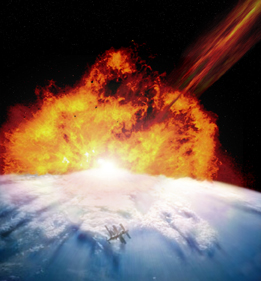Lesson 4
1. Lesson 4
Module 1: Probability
Lesson 4: Applications and Problem Solving
Focus

Photodisc/Thinkstock
NASA’s Near Earth Object Program identifies and tracks objects that will pass nearby Earth. They display information about these objects daily, including a probability that the objects will collide with Earth. On January 6, 2012 the two objects with the highest probability of hitting Earth were named “2011 UZ255” and “2011 VG9.” 2011 UZ255 had a diameter of 75 m and a probability of 0.000 029 of colliding with Earth. 2011 VG9 had a diameter of 120 m and a probability of 0.000 002 3 of colliding with Earth.
Should you be worried that an object from space will strike Earth? If one of the objects listed above did strike Earth, is it likely that you would be affected? How much should governments invest in defending Earth against objects like asteroids?
You can look up information from the Near Earth Object Program at the following websites:
In this lesson you will explore when and how to apply odds and probabilities to help solve problems.
Lesson Outcome
At the end of this lesson you will be able to use probability and odds to help make decisions.
Lesson Question
In this lesson you will investigate the following question:
- How can probability and odds be used to help make decisions?
Assessment
Your assessment may be based on a combination of the following tasks:
- completion of the Lesson 4 Assignment (Download the Lesson 4 Assignment and save it in your course folder now.)
- course folder submissions from Try This and Share activities
- additions to Glossary Terms
- work under Project Connection
Materials and Equipment
You will need
- calculator